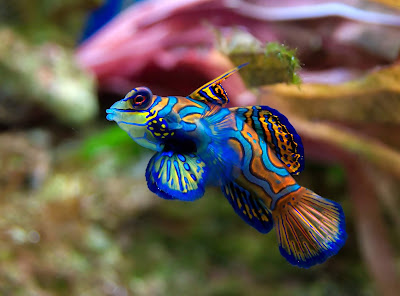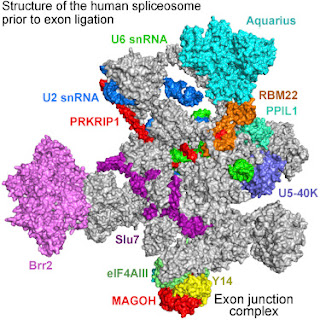Engines of Beauty
"Mandarin Fish," the winning work from a recent art contest, shown above (courtesy of Wikipedia), was produced by the world's most prolific and accomplished artist, variously known as "Meaningless Random Mutations" or the Lord God. See "Synchiropus splendidus" at Wikipedia. However the design was first created, the custom reprints are continuously manufactured through the standard manufacturing engines of carbon-based life based on numerous genes encoded in DNA. The cellular machinery decodes DNA to produce proteins that in turn assemble and produce the structures of each organism including the colors and patterns we see on the outside.
As beautiful as the mandarin fish is, its reprint engine is even more stunning. That basic cellular machinery for making proteins is what creates so much beauty and wonder, or, if you insist, meaningless junk.
There is so much to marvel at in the cellular engines that create the bodies of the complex creatures known as Eukaryotes, the organisms whose cells have a nucleus enclosed within membranes, in contrast to bacteria and some other single-celled organisms. Just one of numerous aspects of your cellular engines to contemplate is the stunningly beautiful spliceosome. Spliceosome? Yep, and it's a beauty. Just look:
Maybe you're shaking your head and saying, "I just don't get modern art." But this is very ancient art, and it's art you need to survive. But it was only recently uncovered and framed for mankind to enjoy, though it's been there all along helping you and your ancestors to manufacture the proteins you depend on. In fact, it's something of a miracle/really interesting meaningless accumulation of random mutations.
The miracle involves a dirty little secret of biological science. Everyone knows that genes encode proteins. Each protein from a gene, with many thousands of genes for many thousands of proteins, right? But there's a problem you might not have heard about: there are a lot more proteins in your body than there are genes to encode them. We have about 20,000 genes, but over 100,000 proteins. How is that possible? Is there some kind of cover-up going on? No, not a cover-up, but another engine of beauty, a small machine in your cells that runs around splicing. There's a word you ought to contemplate whenever you look at a beautiful creature like the mandarin fish or your spouse. The word is SPLICEOSOME (say it like "splice -- oh -- sohm" which rhymes with Rome).
The spliceosome is an incredible machine that assists in transcribing information from your genes. Spliceosomes cut out certain parts and assemble information multiple regions of your DNA to create more proteins than there are genes. We rely on them, and when something goes wrong with spliceosomes, humans suffer from genetic disease. "Around 35% of human genetic disorders are caused by a mutation that alters the splicing of a single gene," according to a great article on spliceosomes at Cell.com. Also see X. Zhang et al., "An Atomic Structure of the Human Spliceosome," Cell, vol. 169, issue 5 (May 18, 2017): 918–929. Or see Wikiepedia's article, "Spliceosome." A basic explanation is given at "One gene, many proteins – alternative splicing" at ScienceExplained.com.
The spliceosome is an engine of miraculous beauty, allowing human life and most multi-cellular life to be remarkably efficient in their reprint engines that keep this world going in such beautiful ways. Only recently discovered, but has been there all along, a work of brilliant art and stunningly advanced technology/random chance that we Eukaryotes depend on. Technology so sophisticated, so cool, so other-worldly, that it almost makes me tremble to contemplate it. How is this even possible no matter how intelligent the designer is? It is beyond our comprehension, though every step of the way toward understanding it awaits a potential Nobel prize to those who are intelligent enough to figure out bits and pieces of how this machine works. And yet somehow the marvel of the machine itself has nothing to do with intelligence but is merely the result of random, meaningless mutations? Now that's what I call faith.
Continue reading at the original source →





